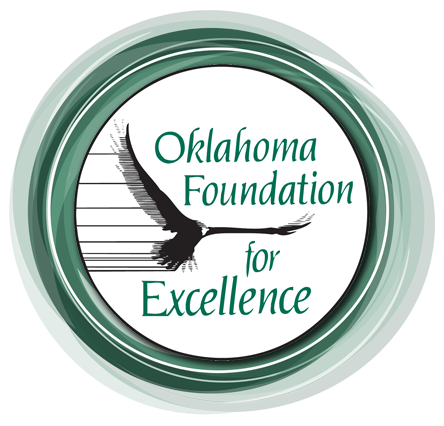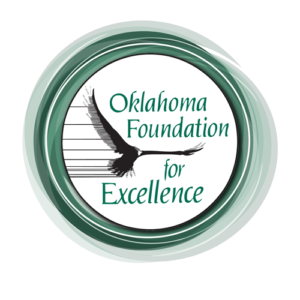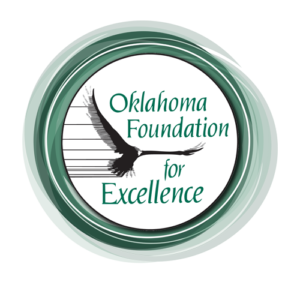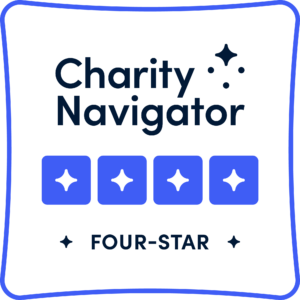Q&A – Jamestown: Three Cultures, One Land
Students submitted hundreds of questions that we were not able to address during the live program “Jamestown: Three Cultures, One Land.” We are grateful to Jessica Pedrick, Sally Stook and the education staff from Jamestown-Yorktown Foundation for taking time to answer so many students questions . We hope you and your students will enjoy reading their responses.
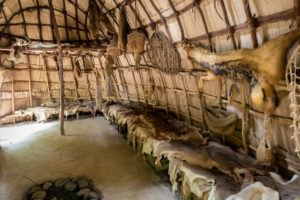
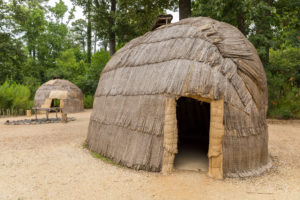
Q: From Nick in Miami: How do they build their houses?
A: Hi Nick! The Powhatan built their longhouses, or yehakins, using saplings (young trees) as the frame and weaving mats out of marsh reeds (tall grasses) to cover the frame. The English and African cultures both used a variation of something called “wattle and daub”.
Q: From Dorrion: How did people get the fur?
A: Hi Dorrion. The Powhatan people got fur mainly by hunting and trapping. They would hunt white-tailed deer, raccoon, opossum, turkey, squirrel and rabbit, among others. The English would trade with the Powhatan to get furs like beaver, which was an animal the Powhatan people trapped rather than hunted.
Q: From Mrs. Pendley’s class in Bartlesville: What did they make bows and arrows out of?
A: The English wrote down that Powhatans preferred locust and cedar trees for their bows, and river cane for their arrows.
Q: From Bryar in Mrs. Thompson’s class in Oklahoma City: Did the Powhatan have jewels?
Hi, Bryar. Pearls from oysters and various cuts of shells were their main “jewels” for adornment. Later, when the Powhatan traded with the English and other Europeans, they would adorn themselves with copper trinkets including copper bells and Italian glass beads.
Q: From Kaleb in Miami: How would they get more shells?
A: Hi, Kaleb, one of the things you can always find in Eastern Virginia is shells. The Powhatan towns were situated along the rivers so that they could collect clay, river reeds, fish, and shells. I hope you get a chance to come to Virginia Beach one day soon.
Q: From Carter in Norman: Did they wear anything other than aprons?
A: Hi Carter. Sometimes leggings were worn for hunting or travelling in difficult terrain and sometimes for special ceremonies.
Q: From Mrs. Geist’s class in Norman: Do you speak one of the Native American languages?
A: Hi, Norman, sadly we only have about 200 words we still know from the Powhatan language.
Q: From Kate: Did the Powhatan eat the animals after they skin them?
A: Yes, Kate. Deer, raccoon, opossum, bear, beaver, etc. were all eaten by the Powhatan people. In fact, the beaver’s tail was considered to be a delicacy among the Powhatan people.
Q: From Mrs. Shannon’s class in Broken Arrow: Where did the fur come from?
A: Hi Kathy! Do you mean the fur we used during the program? They are all real! A lot of the deer fur was donated to us from a local hunt club. We also purchase some from a company to use for educational purposes.
Q: From Mikey in Broken Arrow: What was an everyday item the Powhatans used?
A: Hi Mikey. Fire was definitely an everday item the Powhatan used. Fire cooks your food, warms your house, and smokes your furs and other foods.
Q: From Trinity in Miami: What all did they use the oyster shells for?
A: Hi Trinity. Shells made wonderful scrapers when working with a deer hide or digging out a canoe.
Q: From Paislee: Did they use lavender to color clothing?
A: What a cool idea, Paislee, but to my knowledge, I don’t think so. They did however use various berries, plants and roots.
Q: From Natalie in Edmond: What did they make the bow and arrow from? Did they have arrowheads?
A: Hi Natalie. For bows, the Powhatan would use locust and cedar trees. Arrows were made from rivercane. Arrowheads were made from stone, bone, antler and shell, to name a few.
Q: From KeeLee: Why was copper so important to the Powhatans?
A: Copper was important because it was something that was very scarce, or hard to get. Think about for example, a rare diamond, which is something that is hard to get- because it is rare!
Q: From Breckin: Would the Native Americans put on war paint?
A: Nice question, Breckin. Yes, it is known that the Powhatan men painted their shoulders and faces with pigments, red and black, for various reasons including warfare.
Q: From Samuel: What did the Powhatan sleep in?
A: Good question! The mother and father usually slept on a bench (bed), and the children slept on the floor covered in furs.
Q: From Harmonee: Do they have bow and arrows?
A: Hello, Harmonee. All three groups that came to Jamestown were familiar with bows.
Q: From TJ in Ryan: What did the Powhatans use to make their shoes?
A: Hello TJ! The word moccasin is actually a word we borrow from the Powhatan Indians’ language, Algonquian. We believe that they used deer skin or other animal skins to make the leather for their moccasin shoes. Typically, Powhatan people only covered their feet and legs when they were leaving their towns and villages. Otherwise, they were barefoot.
Q: From Kira in Lawton: Did they wear moccasins?
A: Hello Kira! Usually Powhatan wore moccasins when leaving their town and villages.
Q: From Mathew in Shawnee: Are the powatan still here in 2021?
A: Yes, Matthew! Today there are 11 Powhatan Indian-descended tribes recognized by both the State of Virginia and the Federal government.
Q: From Mrs. Scott’s class in Enid: We are wondering why the Powhatan painted their skin.
A: Hi, Mrs. Scott’s class! Here is a great video that will answer your question! https://www.youtube.com/watch?v=YXjrNWHJymo
Q: From Mrs. Dettle’s class in Enid: Why did native Americans under the age 10 not wear clothes?
A: Hey, Mrs. Dettle’s class, it was never written down WHY Powhatan did this, but they certainly did. One theory is that making clothes was hard work and it made little sense to keep making clothes for children that were constantly growing.
Q: From Laura in Mrs. Scott’s class in Enid: I want to know why the Powhatan did not wear clothing as children.
A: Hi Laura. They never wrote down why, but clothing wasn’t worn until around age 10.
Q: From Arianna: Why do the 10 year old and under not wear clothes?
A: Hi, Arianna. They never wrote down why, specifically! Think about things in your culture that may seem “different” to others.
Q: From Hailee-Mae: Why do the 10 and under not wear clothes?
A: Hello, Hailee-Mae. They never wrote down why, but we do know making clothes is hard work and it does make sense for the person to stop growing before wearing clothes.
Q: From Trevor: Did the Powhatan encounter stuff like rats?
A: No, not until the English came. Rats found there way onto English ships and were introduced to Jamestown when they arrived.
Q: From Tegan in Mr. Dewbre’s class in Ryan: How did the Powhatans get their seeds?
A: Greetings, Tegan. Every plant you eat has seeds inside, so you could grow more!
Q: From Crosby in Mr. Dewbre’s class in Ryan: What crops did they plant?
A: Hi Ryan. The Powhatan obtained about half of their food through farming, which was done in the summer months. Using a system of small mounds, women and children planted corn and bean crops, placing squash and gourds in-between. Corn, the most important crop, as well as beans and squash, were dried and preserved for later use throughout the year. Dried gourds could be used as musical instruments or for bowls, cups, and scoops. To supplement their field crops, particularly in late winter and spring, they gathered fruit, nuts, grain, tubers, and roots.
Q: From Coree in Mrs. Hale’s class in Bartlesville: Did any of the people wear things to camouflage themselves?
A: Hey, Coree. There was not too much camo used in warfare. The Powhatan mainly used camouflage for hunting. If they wore the furs of a deer, they would blend right in! We do know that the Powhatan men did paint their shoulders and face with colors of black and red for various reasons, such as warfare.
Q: From Ryleigh in Mrs. Ledford’s class in Tecumseh: What other copper objects were used?
A. Greetings Ryleigh. The English copper was mostly for pots and pans. The Powhatan used it primarily for jewelry.
Q: From Kenneth: Was gold more valuable to the Powhatan than copper?
A: Hey, Kenneth. The Powhatan people placed more value on copper. The Europeans definitely placed more value on gold.
Q: From Jacob in Mrs. Bell’s class in Felt: Did the Powhatan war with other clans?
A: Hi, Jacob. Good question! Rival Native American groups fought each other just like rivals in all parts of the world. War is how Chief Powhatan was able to force some of the 32 tribes under him to recognize him as leader. Not all of his tribes got along, so warfare among them was also possible. The Powhatan Indians would certainly also fight their rivals from time to time as well.
Q: From Bella in Mrs. Moore’s class in Midwest City: Are the shells a source of income for the Powhatan?
A: Hi, Bella. From time to time, shells were used as a trade item.
Q: From Mrs. Goodwin’s 5th grade in Norman: What tools did they use to make their weapons?
A: Powhatan people were mainly going to rely on stone knives and stone axes. Bows would be made from deer tendon and wood. Arrows would be made from deer bone as well as stone.
Q: From Andrew: Did the Powhatan and others make friendship?
A: Hi, Andrew. The final peace treaty between the English and the Powhatan was in 1646. Today, there are 11 Virginia Indian tribes recognized, most of them descended from the Powhatan Indians.
Q: From Vinny in Broken Arrow: Were the feathers the Powhatan wore purely decorative, or did they have another purpose?
A: Vinny, that’s a great question. As far as we know, the feathers were just for decoration.
Q: From Mrs. Hindman’s class in Bartlesville: Did they use the copper for arrowheads?
A: Hi, Mrs. Hindman’s class, even though the Native Americans had copper, they were not manipulating it into tools. Copper is pretty soft and flexible by itself. To make it stong enough for tools or weapons, you need to mix it with other metals to make bronze or brass (much stiffer, but not as much as steel) which the Powhatan Indians did not do.
Q: From Carter: Did they wear any thing else other than the aprons?
A: Good question, Carter. There is mention of leather mantles being worn by people that are more important. There was even mention of a feather mantle. (A mantle is a loosely fitting dress-like garment worn over one shoulder). Of course, furs were worn to keep people warm and to show off their importance as well. Lastly, there is a note that silk grass was used to make clothing as well.
Q: From William in Mrs. Yarborough’s class in Grove: What did the Powhatan women wear? Did they wear aprons?
A: Willam, great question! Women did wear leather aprons. Here is a video that will answer your question further: https://www.youtube.com/watch?v=YXjrNWHJymo.
Q: From Shanon in Drumright: How did they make the animal skin skirts?
A: Shannon, Powhatan Indians used a method called Brain Tanning – using the animal’s own brain to soften the skin enough to be worn.
Q: From Virginia in Broken Arrow: What did they put on their feet when they went to fight?
A: Hi, Virginia! Great name! Moccasins were worn on the feet of Powhatan people when they left their towns/villages. The word “mocassin” is actually part of the Powhatan Indian language, Algonquian.
Q: From MIchael in Broken Arrow: What did the Powhatans celebrate?
A: Hello, Michael. For celebrations, the Powhatan mainly celebrated good harvests and good hunts.
Q: From Joseph in Mrs. Yarborough’s class in Grove: What did the Powhatans use if they were sick?
A: Hello, Joseph. For the Powhatan Indians, their natural environment provided food, shelter and also a natural pharmacy of medicines for diseases and ailments. They relied on grasses and native plants such as bloodroot, tuckahoe, cattails and cordgrass.
Q: From Dalton: What did they eat?
A: Hello, Dalton. In Virginia, they ate raccoon, opossum, duck, squirrel, geese, deer, rabbit, seafood, corn, beans, squash, etc. How many of these do you still eat?
Q: From Samuel: What did the Powhatan sleep in?
A: Hi Samuel! From what we can tell, Powhatan Indians generally slept on raised “beds” that were covered in animal furs. Sometimes chldren might have to sleep on the floors on mats and furs.
Q: From Nick in Miami: What did they eat?
A: Hello Nick. In Virginia, they ate raccoon, opossum, duck, squirrel, geese, deer, rabbit, seafood, corn, beans, squash, etc. Yum!
Q: From Emma: What kinds of things did they eat?
A: In Virginia, they ate raccoon, opossum, duck, squirrel, geese, deer, rabbit, seafood, corn, beans, squash, etc. No McDonald’s for them!
Q: From Melissa: Where did they get the string from?
A: Good question. The Powhatan were able to make rope from deer leg tendon or the backstrap (tenderloin) of the deer. The hide of the deer as well as the gut, could also be used as string. The Powhatan could also use the fibers of some plants, like the yucca plant.
Q: From Ke’Mya: How did they wear there hair when they went hunting?
A: Ke’Maya, it is believed by the English that one reason Powhatan men kept the right side of their head shaved and the left side long was to prevent the hair from being in the way of using the bow and arrow.
Q: From Paige in Miami: Was there a certain way the Powhatan people had paint on them depending on their age or rank?
A: Great question, Paige! We do think there was religious and spiritual meaning for how the Powhatan Indians painted themsleves, but it would vary from individual to individual.
Q: From Zane in Broken Arrow: How did Powhatans hunt for food?
A: Hey Zane! The Powhatan men used bows and arrows mainly to hunt large prey. They wore animals skins for camouflage and often worked together, having some men drive the large animals into areas where other men could kill them. They would also use nets and traps to capture smaller animals.
Q: From Lane in Miami: How many Powhatan are still in Oklahoma?
A: Hello Lane! Virginia recognizes 11 Virginia Indian tribes today. At least 7 of these are directly descended from Powhatan tribes. Others, like the Monacans, existed in 1607 but were not part of Powhatan’s chiefdom. There many people today all around the country who are descendents of the Powhatan tribes.
Q: From Rayden in Drumright: Did the women in the tribes fight in battles?
A: Hello, Rayden. It was not part of the Powhatan culture to have women fight, but same was true of most Eurpoean and African cultures at the time.
Q: From Kenneth: Was gold more valuble then copper to the Powhatan?
A: We don’t know if the Powhatan had much use for gold or silver. Copper had the highest value to Powhatan Indians.
Q: From Anna Kate in Mrs. Nicholson’s class in Sapulpa – What did they use to tie their jewelry together? How did they get string/rope?
A: Anna Kate, most string for jewelry was animal tendon, usually deer.
Q: From Andrea: What happened to the Powhatan when they lost their land?
A: Thanks for the question, Andrea! The Powhatan faced several choices: some fought to get their land back, some moved away from the English to a new place, and some stayed near the colony and tried to live more like the settlers. Eventually, some that stayed near the English were placed on reservations, which still exist today and and are open to the public to visit.
Q: From Cameron: Do people still use tomahawks?
A: Cameron, “tomahawk” is an actual Powhatan word, but during this time period, it was just a wooden war club. Over time, the word came to mean a metal war axe. Few people use them as weapons today, but becasue they are axes, they can be useful in camping.
Q: From Hailee- Mae: Did they have pets?
A: Hi Haille- Mae! We think all three cultures had some sort of pets, but the animals might vary due to location.
Q: From Chance in Drumright: What types of fruits did they have in Virginia at the time?
A: Good question, Chance. Virginia had fruits like paw paws, persimmons, and passion fruit.
Q: From Thomas in Mrs. Stramski’s class in Nicoma Park: Did the Indians ever destroy entire colonies?
A: Hi Thomas. In 1622 and 1644, they definitely came close.
Q: From Christopher: Did they have war?
A: Christopher, the Powhatan and English fought off and on for 40 years.
Q: From Caroline in Broken Arrow: Were the Powhatans friendly to begin with?
A: Caroline, it is tough to define “friendly” in this situation. I am sure there were plenty of friendly people in all of the cultures. However, remember the English and the Powhatan had different views of the land. They were also speaking different languages at the time, so communication was probably more difficult. These cultures did fight off and on for 40 years, but remember, there were many times of peace.
Q: From Amber: Did the Indians worship eagles?
A: Amber, this was true for some Indian groups, but this was not written down for the Powhatan people.
Q: From Molly in Mrs. Nicholson’s class in Sapulpa – How were the chiefs chosen?
A: Good question, Molly. The fancy word is “matrilineal’ This simply means that all the children of the same mother were in line to become chief.
Q: From Cason in Mrs. Arnold’s class in Norman: What plants did the Powhatan grow?
A: Hi Cason, great question. The Powhatan grew a variety of plants like corn, beans, squash, pumpkins, sunflowers, gourds, tobacco, herbs, a type of passionfruit, and more. Here is a webcast where you can learn more: https://www.historyisfun.org/video/life-of-the-powhatan-indians-farming/
Q: From Nick in Lawton: Didn’t the Native Americans cross to Americas from Russia?
A: Nick, sadly no one really knows, but you have mentioned a theory that is very popular.
Q: From Lane in Miami: Where do the Powhatan live now?
A: Lane, we have two reservations here in Virginia for the Pamunkey and Mattaponi tribes, but most Powhatan descendants live in neighborhoods like everyone else. By now, I bet they live all over the world!
Q: From Emily: What were aprons made out of?
A: Emily, the aprons were made from deer hide.
Q: From Samuel: Do the Powhatans and the English still battle?
A: Hi Samuel. These two cultures fought briefly the first day they met and there was off and on fighting all the way until 1646, which was the final peace treaty.
Q: From Jayden in Miami: About how long would the fights go on with the settlers and the Indians?
A: Hi Jayden. These two cultures fought briefly the first day they met and there was off and on fighing all the way until 1646, which was the final peace treaty.
Q: From Simon in Broken Arrow: How old did you have to be to start hunting or fighting?
A: Hello, Simon. For the Powhatan, it was the father’s decision when to teach the kids those important skills. Mothers, however, were involved in introducing these skills at younger ages.
Q: From KeeLee in Miami: Why did the Powhatan want copper so bad?
A: Hi KeeLee. Copper was the only metal the Powhatan were using until Europeans arrived.
Q: From Peyton in Mrs. Stramski’s class in Nicoma Park: Were the Indians allowed to mine jewels?
A: Hi, Peyton. The Powhatan people were not mining for metal at this time in history.
Q: From Gracie in Mrs. Nicholson’s class in Sapulpa: Why were the children not allowed to have clothing until they were older?
A: Hi Gracie. In the Powhatan culture, it was “normal” for the children to not wear clothing. Think about things in your culture that may seem “different” to other cultures. For example, do you eat fried onion burgers in Oklahoma? I’ve never had one of those here in Virginia!
Q: From Andrew in Miami: What animals did the Powhatan hunt?
A: Hi Andrew. They hunted raccoon, opossum, duck, geese, rabbit, bear, and deer.
Q: From Carter in Lawton: Did the Powhatan wear anything other than aprons?
A: Good question, Carter. Besides aprons, important people in the tribes wore leather mantles. There was even mention of a feather mantle. (A mantles was a loosely fitting dress-like garment worn over one shoulder. Of course, furs were worn to keep people warm and to show off their importance as well. Lastly, there is a note that silk grass was used to make clothing as well.
Q: From Brighten in Claremore: Was there ever a time where the Indians and the colonists get along?
A: Hi Brighten. There was a small period of peace when Pocahontas got married to John Rolfe in 1614, but the final peace treaty was not until 1646.
Q: From Alex in Mrs. Stramski’s class in Nicoma Park: Did the Indians eat turtles?
A: Hi, Alex. Yes, we do believe they ate turtles! Additionally, the shells were used as serving platters.
Q: From Israel: Were there any fights between the Powhatan Indians?
A: Hi Israel. Yes, sadly the English and Powhatan Indians did have fights. The colonists write that they were attacked shorty after their landing. The two sides fought from time to time in small battles and larger wars between 1609-1646.
Q: From Arion: How would tribes treat sick people?
A: Hi Arion. For the Powhatan Indians, their natural environment provided food, shelter and also a natural pharmacy of medicines for diseases and ailments. They relied on grasses and native plants such as bloodroot, tuckahoe, cattails and cordgrass.
Q: From Brooklyn: How much would they go to war?
A: English settlers and Powhatan Indians fought briefly the first day they met, and there was off and on fighing all the way until 1646, which was the date of the final peace treaty.
Q: From Sarah in Miami: What did Native American woman wear during this time in history?
A: Hi Sarah. The Powhatan women wore a lot of the same clothing as the men, including that leather apron. Here is a great video about Powhatan women’s clothing: https://www.youtube.com/watch?v=YXjrNWHJymo
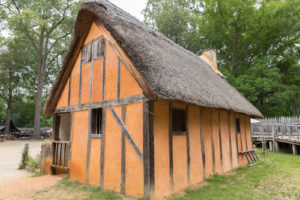
Q: From Hannah V.: Was the wool real that you were holding?
A: Hi Hannah! Yes it was! All the furs we showed were real!
Q: From Aubree in Drumright: Do you know how many sheep it took to make a fur to wear?
A: Hi Aubree, if you are wearing it as a cloak or vest then probably 2, but you can get lots more clothing if you keep cutting the sheep’s fur and using it for wool items.
Q: From Aubrey from Oak Crest Elementary in Broken Arrow: Did the woman make the clothes?
A: Hi Aubrey! For the Powhatan Indians, both men and women would make clothes from deer skin, each having different roles to play in making them. For the English, it is fair to say that some women could make clothing, but during this time professional tailors (who designed and made the patterns to sew) were men, while women could be seamstresses who sewed them toghether.
Q: From Paislee Lane: Did they use indigo for coloring clothing?
A: The English certainly would use indigo for clothes, but it was very expensive. Few average people would wear blue clothes.
Q: From Abbie in Lexington: What does tenant mean?
A: Hi, Abbie. This term usually means someone who lives in a place, but does not own that place. Tenant farmers owed rent, which they often would pay by turning over a portion of their crops (tobacco, wheat, corn) to their landlord. If they had anything left after paying the rent, they could keep it for themsleves.
Q: From Austin Davis: Did the tenant farmers get paid?
A: Great question Austin! They did not get paid a salary or wages. Tenant farmers owed rent, which they often would pay by turning over a portion of their crops (tobacco, wheat, corn) to their landlord. If they had anything left after paying the rent, they could keep it for themsleves. Whatever they did not use to live, they were free to sell to make some cash. If they saved enough money they might eventually be able to buy some land for themselves.
Q: From Nate: Can the horns be used for spoons?
A: Yes Nate, horns can absolutely be made into spoons. Many settlers in the colonies did this once they had their own farms with animals like bulls. The horn gets soft when heated and can be molded into a spoon shape that stays when it is cooled.
Q: From Tamara Moore’s class in Midwest City: How are the king and Queen of England chosen?
A: In general, the crown is passed from the king to his oldest surviving son. If no sons are left, it can pass to a daughter, then to another living male relative or his family.
Q: From Ke’Mya of Lawton: What did England use to make there wall?
A: Ke’Mya, great question! Here’s a video to answer your question: https://www.youtube.com/watch?v=wtTGsXOvfsc
Q: From Jonas: How did Jamestown get made?
A: Hi, Jonas. The English brought various tradespeople to Virginia, such as blacksmiths, sawyers, and carpenters to build James fort.
Q: From R. Miller: How long did it take them to build their fort?
A: Greetings! Captain Christopher Newport wrote down it took them from May 15 to June 15.
Q: From Kameron: How much land do they have?
A: Hi Kameron. During this time period, the English considered Virginia to go all the way to the Hudson River in the North to today’s Georgia in the South. They also claimed it stretched across the land west to Drake’s Bay (San Francisco), California.
Q: From Colby in Sapulpa: Did the English pay for the land and their houses when they came over?
A: Hi, Colby. No one “paid” for the land. The English claimed it when they arrived, which of course caused issues with the Powhatan Indians. The Virginia Company was supposed to provide all the tools and materials needed to build the housing.
Q: From Hanna in Nicoma Park: What was the main reason they landed by the river?
A: The Virginia Company instructed them to build near a site where ships could land. They selected Jamestown for its deep water anchorage and good defensive position.
Q: From Jillian Bradford in Norman: How many people died?
A: Hi Jillian! On the voyage to Jamestown in 1607, one person died, probably from heat stroke. During the “Starving Time” of 1609-1610, approximately 75% of Jamestown perished due to sickness and disease.
Q: From Kaleb in Miami: How many people survived like the settlement?
A: Hi Kaleb, let’s talk about the first year. After 1 year, the population went down from 104 to 37.
Q: From Emily: Why was tobacco so popular? What did they use it for?
A: Hi Emily! The colonists sent tobacco to England for pipe smoking. Growing tobacco made the most money and became their “Cash crop”. Here is a fun video: https://www.youtube.com/watch?v=CijghpUbWHU&feature=youtu.be
Q: From Gemma at Nichols Upper Elementary in Miami: Why were there only men and boys that came over on the ship?
A: Greetings, Gemma! The first settlers were expected to fight and to be trained like soldiers. Women were not trained to be soldiers at this time in history.
Q: From Max: How come no women went on the ships for Jamestown?
A: Max, great question! It was probably due to the roles of men and women during that time. Here is more information: https://www.historyisfun.org/learn/learning-center/what-were-the-roles-of-women-and-children-at-jamestown/
Q: From Lane: Why did woman not go on the ship?
A: Great question. On the first trip, there were many uncertainties such as, would they find a healthy place to live, free of disease? Would there be clashes with Spain and the native people? The military had to be in place before women were allowed to come. They did not know at the time how well women could do in the military!
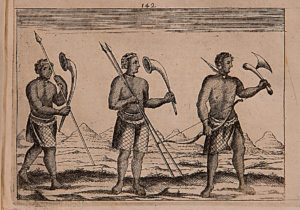
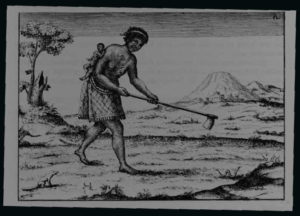
Q: From Lucas in Bartlesville: What was the war like in Africa?
A: Hi Lucas. Africans had bows, spears, and swords as well, but theirs were made from iron. They also had gotten guns from trading with Europeans like the Portuguese who were trying to colonize and trade with African nations. We don’t think they wore armor like the English, but did have some shields to protect them.
Q: From Jett in Nicoma Park: What was the horn used for in Africa?
A: Hi Jett. For the Europeans and West Central African people, the horn was the plastic of the day-making spoons, combs and naturally, horns for blowing.
Q: From Anna in Seminole: How did the Africans find their snail shells in the sand after they buried them?
A: Good question, Anna. As part of the process of burrying the shells before uncovering them to be buffed and shined, I would imagine they were burried in one location to be worked on by multiple people.
Q: From E.J. in Jenks: Is the african hatchet made out of a bone or wood?
A: Great question, EJ. The West Central African axe is made out of wood and metal. Africans practiced metalworking and produced iron and steel tools.
Q: From Ryker in Oklahoma City: How did the Africans get their metal?
A: Hi Ryker, just like Europeans, Africans were mining their metals.
Q: From Charlee: How did the African people get the copper bracelet
A. Hey, Charlee. They were certainly mining metals in Africa during this time. Some copper bracelets were obtained through trades with Portuguese colonizers who made a copy of the bracelet specifically to trade.
Q: From Ms. Qualls’s class in Miami: The copper bracelet, is it made to slip over the wrist or slip on the wrist?
A. Generally, the bracelet was slipped on the wrist and not over the hand. Neat question!
Q: From Carter in Miami: Did Africans use the copper for anything else?
A. Hi Carter. Often, copper was used in artwork or decorations.
Q: From Krista in Oklahoma City: What did they do for entertainment?
A: Hello, Krista. For the English settlers, cards, dice, checkers, ring toss and other games were available. The Powhatan Indians had a form of a stick ball game called “shinny”. For children, a skills game using corn cob darts and other games were played. We do not have much information about the West African people, but we do know a board game called “mancala” comes from the West Central African culture.
Q: From Camden: What kinds of currency were used by different groups?
A: Hi Camden. English money is almost the same then as now. In West Central Africa, money was often copper bracelets called manilla, cowrie shells, and palm cloth. The Powhatan Indians did not use currency, but traded items of value such as furs, copper, and shells.
Q: From Layla in Mr. Karinshak’s class in Norman: How did the Africans put designs in their clothes?
A: Hi, Layla. To our knowledge, they used dyes from local plants to draw and print on their fabric.
Q: From Isaiah in Shawnee: What did they live in?
A: Good question Isaiah. The Powhatan lived in yehakins. Some yehakins were small and round, while others were oblong, with rounded ends to make them more wind resistant. Young saplings were used to create a frame for the house. The people covered their houses with bark shingles stripped from trees, or with mats woven from cut marsh reeds. The English and African houses were similar in that they used a style called “wattle and daub.” The wattle are basically sticks as the frame, and the daub is made of mud and clay.
Q: From Mrs. Goodwin’s class in Norman: What did they do with the pearl from the oyster shell?
A: Hello Mrs. Goodwin’s class! All 3 groups (African, Powhatan and English) were using pearls in their jewelry.
Q: From Cash in Claremore: Is the copper made with anything else?
A: Hello Cash. No, copper is an element by itself (think of the Periodic Table) so copper is only made of…. copper!
Q: From Justin: How did they make their clothes?
A: Good question, Justin. The Powhatan people relied mainly on animal skins (although silk grass is also noted). European people used mainly linen and wool (silks were worn by people of higher status). Cotton was used by the West African people. (A form of palm cloth was worn or used at times by wealthier people.)
Q: From Gabriela in Tulsa: I want to know if they use spears.
A: Gabriela, nice question! In Europe at the time, the English were using them for warfare. This is the same for the West Central African people. The Powhatan were mainly using them for fishing.
Q: From Christopher: Did they have war?
A: Hi Christopher! Unfortunately, war happens way too often, and the people at Jamestown did have war. The English and Powhatan Indians had several wars from 1609 to 1646, and other colonists in other colonies fought wars against Native tribes.
Q: From Bryson in Miami: What did they do with the animals when they killed them?
A: Hi Bryson! Just like today, animals could be used for food, clothing and tools.
Q: From Zyyah in Mrs. Hernandez’s class in Seminole: Where did they get the metal for the tools?
A: Hi, Zyyah. Most metals are being mined.
Q: From Jake in Mrs. Baugh’s class in Drumright: Did they use bows and arrows to hunt yet?
A: Hi Jake! All three groups that met at Jamestown (Powhatan, African, and English) had long histories of hunting with bows.
Q: From Mrs. Trotter’s class in Norman: Did the children have a type of schooling?
A: There were no formal schools for the Powhatan children. They learned from their parents and elders. The English often had private tutors. We do not have information about the education for West African people.
Q: From Mrs. StandingBear’s class in Tulsa: Do they have schools?
A: Olivia, most English schools were private schools and usually only the upper classes could attend. The Powhatan Indians did not have any formal schools. Children learned from their parents and elders.
Q: From Cole in Claremore: What did the kids do?
A: Hi Cole! The Powhatan children helped their parents. Girls weeded gardens, and boys learned to fish and hunt. Young children may also have been placed in small houses in the middle of fields to act as ‘scarecrows’ to keep the crows and other animals from eating the corn crop.
Q: From Josua: Did they use medicinal herbs?
A: Hi Joshua, that is a great question! Medicinal herbs were used by all three cultures at Jamestown and are still used today. What types of herbs they used depended on their environment, and remedies were usually passed down through families. All three cultures had people who tried to heal others, but they probably did not have as much training as doctors do today. Many modern medicines come from plants or herbs.
Q: From Taniyah in Mrs. Reynolds’ class in Oklahoma City: How did they keep the animal meat from rotting?
A: Hi, Taniyah. Most cultures, including the three at Jamestown, knew to hunt in cooler seasons to keep meat fresh longer. All three cultures sometimes dried or smoked meats to preserve them. The English would also salt or pickle their meats in vinegar.
Q: From Jean and Joseph in Mrs. Salesberry’s class in Oklahoma City: What was the housing like? What type of bedding was used?
A: Hello, Jean and Joseph. All three cultures that converged at Jamestown were very good at making warm, dry houses and had some sort of “beds” in their homes to rest in at night.
Q: From Ace: Did they ever find diamonds?
A: Hi, Ace. Diamonds were pretty rare in Virginia, and none were found in Jamestown.
Q: From Camden: What kind of currency did they use?
A: The English used gold and silver coins as their currency. The West Central African people used metal coins, valuable seashells called cowries, as well as copper bracelets called manilla. Eastern Woodland Indians also used shells and beads as a form of currency.
Q: From Jaiden in Pawhuska: How much was gold?
A: Hi, Jaiden. The value of gold is always changing, but being a rare metal, most of the time the value is going up.
Q: From Skiler in Mrs. Taylor’s class in Broken Arrow: How did they make the spears?
A: Hi Skiler. Spears for all three groups were made with long wooden poles, but the English and African cultures were the ones who added metal tips.
Q: From Lane in Miami: Did they ever use the axe to hunt?
A: Hello, Lane. There are no records of ever using an axe to hunt. The idea is that few hunters can get close enough to an animal to use an axe, especially if you have arrows instead.
Q: From Alaina in Tulsa: Did any wars happen in any of the cultures?
A: Hello, Alaina. Yes, unfortunately we know of at least three wars between the English and Powhatan Indians between 1609-1646 when a peace treaty established reservations for two Powhatan tribes. There was on-and-off conflict between the two groups throughout the century. In Virginia, the Powhatan and the English fought one another. The Powhatan Indians also had their own enemies in Virginia such as the Monacans around Richmond. In West Africa, there were wars between the Kings and Queens from different Kingdoms. In England, there were wars between other ruling kingdoms in Europe as well.
Q: From Audra in Felt: How long did the slave trade routes last?
A: Hello Audra. The transatlantic slave trade lasted from about 1500-1850. It is estimated that about 10-12 million people were forced from Africa to come to the Americas during that time. Unfortunately, even though the slave trade from Africa ended, slavery continued to exist for years in countries like the United States (1865) and Brazil (1888). https://www.britannica.com/topic/transatlantic-slave-trade
Q: From Ricky in Felt – Were mostly men, women, or children enslaved from Africa?
A: Hi Ricky. Men, women and children were all taken, but the enslavers were mainly looking for the strongest and the healthiest people.
Q: From Aleyah: How many slaves were there?
A: Hi Aleyah, the records from the period do not always tell us if an African American living in Virginia was enslaved or free. Most were enslaved. By 1700, 1/10 of all Virginians were enslaved. By 1775, it was 2/5.
Q: From Robert in Dale: Is there a definite count of how many slaves were in the Jamestown era?
A: Hello Robert! No, we do not have an accurate number of enslaved people in the colony. Even if someone is identified as being African American, it usually doesn’t say if they were free or enslaved. Most were enslaved, but some could either be servants getting paid or even owning land themsleves in rare cases. Certainly though as time went on, by the 1660s laws regulating slavery and slave status were passed in Virginia showing that the poplulation of enslaved people was growing,
Q: From Luke in Ryan: How did the Africans survive?
A: Good question Ryan! Physically, the English saw the West Central African people as an investment, and it was in the best interest of the English to provide them with the food and medical care needed to survive. With that said, to what quality of care was offered may have been minimal.
Q: From Ella in Noble: Why did they start taking Africans…why not another group?
A: Hi Ella. That is a great question with a very complex answer. Slavery was a part of many cultures including African and European cultures during this time. But what became the Transatlantic Slave Trade, which forced millions of Africans from their homes, began around 1500. Enslaved people in Africa were typically prisoners taken during wars between various African kingdoms and sometimes European countries, like Portugal. The Portugese were often purchasing enslaved West Central Africans and exploiting them for manual labor in brutal conditions. Other European countries joined the Portuguese, so by the 1600s, the English, Dutch and Spanish were following suit. Enslaved West Central African people were then shipped to European colonies across the Atlantic, many bound for Spanish settlements in modern-day Mexico, the West Indies, Brazil, and, eventually, English colonies like Virginia.
Q: From Leanna: Were diamonds available back then?
A: Hi Leanna, people did want diamonds, but no diamonds were found in Virginia!
Q: From Mrs. Smith’s class in Noble: Did slaves try to escape…and if they were successful, did they get far?
A: Hi, there are stories of amazing enslaved people who not only escaped, but actually made it back home to Africa.
Q: From Millie in Marble City: Why did the African people trade their own people when they knew they would be used as slaves?”
A: Great question, Millie. To our knowledge a practice in West Africa is that when different kingdoms fought, the victor would capture the enemy. These people would/could then be put into some form of slavery. The term of enslavement is uncertain. It may not have been for the duration of a person’s life, which became a law in the English colonies starting in the 1660s.
Q: From Eli in Mrs. Taylor’s class in Broken Arrow: Why does the king want to be rich?
A: Greetings Eli. Like everyone else, kings had bills to pay, but they were also paying for armies, castles, roads, and governments.
Q: From Coree in Mrs. Hale’s class in Bartlesville: Did they trade things besides just copper and shells?
A: Greetings Coree. The English brought barrels and barrels of metal fish hooks, sewing needles, scissors, knives, and lots of metal technology ready to trade. From the Powhatan, the English always wanted beaver skins and food.
Q: From Olivia: What type of wood did they use?
A: Hi Olivia, England is a place that has very little wood during this time period. They want hardwoods like oak for building, pine for its sap to make tar/pitch, and sassafrass for medicine.
Q: From Dax in Mrs. Yarborough’s class in Grove: How old was King James when he started ruling England?
A: Hi Dax, he was 47 years old when he became king.
Q: From Harper: Did the Spanish ever start colonies?
A: Hi Harper. The Spanish were the first Europeans to start colonies in the New World. By the time of Jamestown, the Spanish had colonized what is now the Southwest United States, Mexico, Central America, and parts of South America and the Caribbean. The Spanish even claimed that what became Virginia was actually part of Spanish Florida!
Q: From Brayden: Did they ever find gold by digging in the ground?
A: Hi Brayden, actually the Jamestown settlers never looked in the right places for gold. Some gold was found in Virginia, in about the year 1700 near a place today called Fredericksburg (about halfway between Washington, D.C., and Richmond). It wasn’t nearly as much gold as the famous 1840s gold rush in California though!
Q: From Kira in Flores: Was there actually gold in Virginia?
A: Hi Kira! Virginia does have gold. Some was found in Spotsylvania County around 1700, and the largest gold strike in America was in Buckingham County – that is until 1848, when gold in California was discovered.
Q: From Maya: What ships did they use?
A: Hi Maya, great question! The English had three ships that came to Jamestown in 1607: The Susan Constant, the Godspeed, and the Discovery. Here’s a great video about the ships: https://www.historyisfun.org/video/ship-shape/
Q: From Luca in Tulsa: I was wondering about the Spanish conquistadors who got gold from the Central Americans.
A: Good question, Luca. It was these Conquistadors that proved to Europe that there was gold in the New World and put the idea in the minds of the English to try and get some for themselves.
Q: From Leanna in Shawnee: Were diamonds available back then?
A: Yes Leanna, but not so much in Virginia.
Q: From Madi in Mrs. Hodgins’ class in Seminole: Were diamonds ever found and used along with the gold and copper?
A: Hi, Madi. Very few diamonds have been found here in Virginia.
Q: From Emmi in Miami: Did the Portuguese, Spanish, and English fight over certain areas of land such as Spanish Florida or South American countries that were colonized by the Portuguese? Or did they just allow other nations to keep the land?
A: Hello, Emmi. Spain planned some attacks, but eventually came to believe Jamestown was not worth their trouble.
Q: From Seth in Mrs. Hindman’s class in Bartlesville: How long did it take them to travel from Virginia to West Africa?
A: Seth, a trip across the Atlantic during this time would be around three months on average.
Q: From Boston in Miami: When did slavery end?
A: Hi Boston. Slavery ended officially in the United States in 1865 when the 13th Amendment to the constitution was ratified (accepted) by the states. But you may have learned that during the Civil War (1861-1865) many northern states had ended slavery in their states before that date. At the time of the war, there were 34 states- 15 slave and 19 free. The last big country to end slavery was Brazil in 1888.
Q: From Bella in Tulsa: Did girls work on the plantation?
A: Hi, Bella. Tobacco was very labor intensive and at times, almost everybody worked.
Q: From Aven in Mrs. Hindman’s class in Bartlesville: Did they ever find any gold or silver in Mexico?
A: Yes, Aven. Mexico was a major silver and gold producer for Spain.
Q: From Keelee in Miami: If the Powhatan lived in Virginia then how did they know about the Spanish people?
A: Hello, Keelee! The Spanish had explored much further north than just Florida. In fact, they had visited the Chesapeake Bay (in Virginia) in the 1500s and set up a religious mission that was eventually destroyed by the Powhatan Indians. Also, since the Powhatan Indians traded with others all over Eastern United States, they would hear of other Native people’s experiences with the Spanish.
Q: From Ashley: How expensive was the copper that they traded for people?
A: Hello Ashley! What the copper was worth would change over time. We know of at least one point in time when an enslaved person could be bought for about 220 copper manilla.
Q: From Jacob in Mrs. Hindman’s class in Bartlesville: How often were slaves fed?
A: Hi Jacob! We really don’t know the answer to that question. We are pretty sure they had enough to eat so they could continue to work in the jobs they were forced to do, but how yummy the food was or how often they ate probably depended on the slave owner.
Q: From GiYana: How do we find more info about this?
A: GiYana, great, general question! Learn more at our website: www.historyisfun.org
